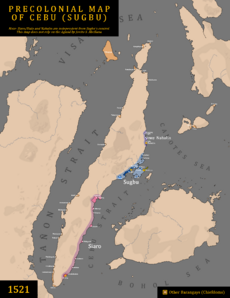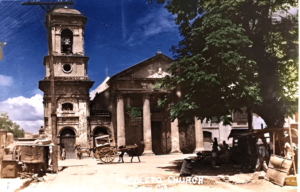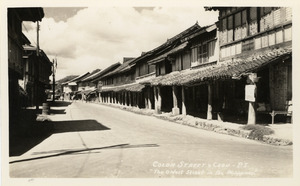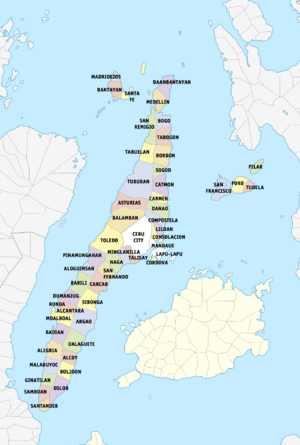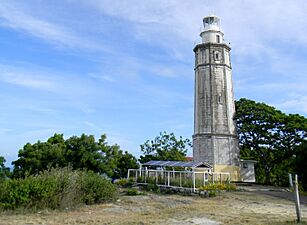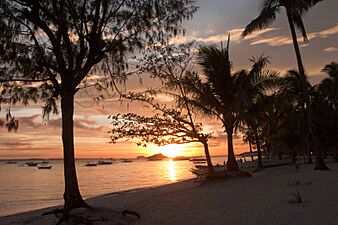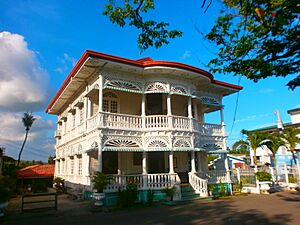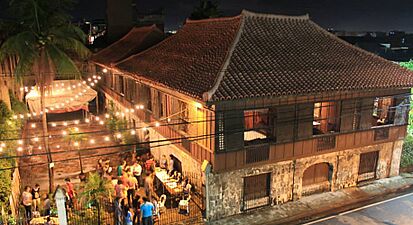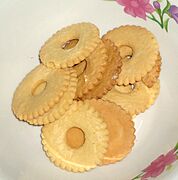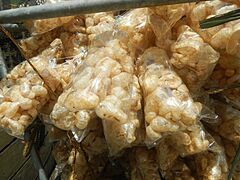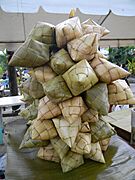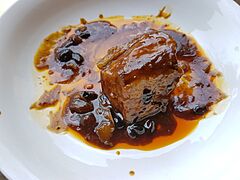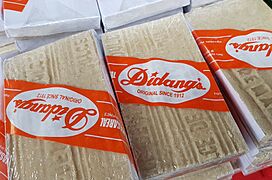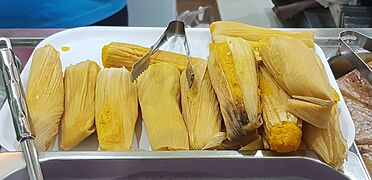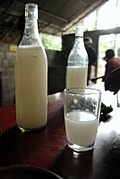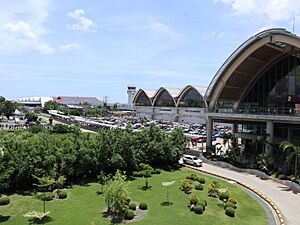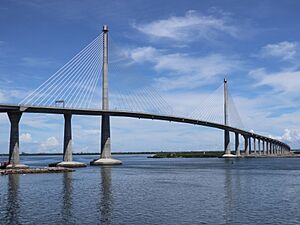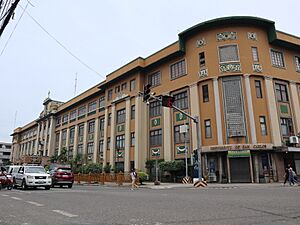Cebu facts for kids
Quick facts for kids
Cebu
Sugbo (Cebuano)
|
||||||
|---|---|---|---|---|---|---|
|
Left to right, from the top: Osmeña Peak, Magellan Monument, Kawasan Falls, Cebu Metropolitan Cathedral, Cebu City, Malapascua Island, Cebu Provincial Capitol
|
||||||
|
||||||
| Nickname(s):
The Gateway to a Thousand Journeys
|
||||||
| Anthem: Sugbo (Cebu) |
||||||
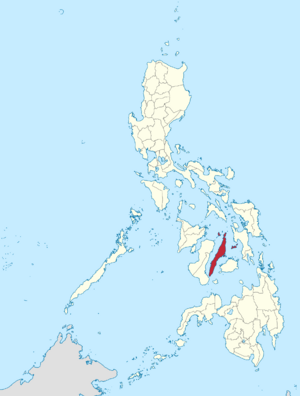
Location in the Philippines
|
||||||
|
OpenStreetMap
|
||||||
| Country | Philippines | |||||
| Island Group | Visayas | |||||
| Region | Central Visayas | |||||
| Founded | 6 August 1569 | |||||
| Capital and largest city |
Cebu City | |||||
| Government | ||||||
| • Type | Sangguniang Panlalawigan | |||||
| Area | ||||||
| • Total (province) | 4,943.72 km2 (1,908.78 sq mi) | |||||
| Area rank | 20th out of 81 | |||||
| excludes independent cities | ||||||
| Highest elevation
(Osmeña Peak)
|
1,072 m (3,517 ft) | |||||
| Population
(2020 census)
|
||||||
| • Total (province) | 3,325,385 | |||||
| • Rank | 5th out of 81 | |||||
| • Density | 672.6483/km2 (1,742.1512/sq mi) | |||||
| • Density rank | 7th out of 81 | |||||
| • Voter (2025) | 3,407,780 | |||||
| • Language | Cebuano Forohanon Bantayanon |
|||||
| Population data excludes independent cities | ||||||
| Divisions | ||||||
| • Independent cities | ||||||
| • Component cities |
6
|
|||||
| • Municipalities |
44
MultiReplace: Unpaired argument:
6 = *Toledo |
|||||
| • Barangay |
|
|||||
| • Districts |
|
|||||
| Time zone | UTC+8 (PST) | |||||
| IDD : area code | +63 (0)32 | |||||
| ISO 3166 code | PH-CEB | |||||
| Income class | 1st class | |||||
| PSGC | [https://psa.gov.ph/classification/psgc/?q=psgc/barangays/{{#pro000®code={{&provcode=
|
|||||
| Patron | Santo Niño de Cebu | |||||
| Website | www |
|||||
Cebu (/sɛˈbuː/ SEB-oo; Cebuano: Sugbo), officially the Province of Cebu (Cebuano: Lalawigan sa Sugbo; Filipino: Lalawigan ng Cebu), is a province in the Philippines. It is part of the Central Visayas region and includes a main island plus 167 smaller islands. The coastal areas of Cebu are known for having some of the richest marine life in the Coral Triangle.
Cebu City is the capital and largest city. It is often called "the Queen City of the South." Cebu City is the oldest city and was the first capital of the Philippines. It is politically separate from the provincial government, just like Mandaue and Lapu-Lapu City. The Cebu Metropolitan Area is the third largest metropolitan area in the Philippines. Cebu City is a major center for business, trade, education, and industry in the Visayas. It is also the main regional center for Central Visayas.
Cebu is one of the most developed provinces in the Philippines. Over the past ten years, it has become a global hub for business services, tourism, shipping, furniture making, and heavy industry. Mactan–Cebu International Airport, located on Mactan Island, is the second busiest airport in the Philippines.
Cebu has the most cities and towns combined of any province in the Philippines, with 53 in total. It has nine cities, which is the second highest number after Negros Occidental.
Contents
What's in a Name?
It is not fully clear if the island was named sugbó or if this was the name of the settlement where Ferdinand Magellan's crew arrived in 1521. The capital city is also named Cebu City.
The name might come from an old Filipino word *sug(e)bu. This word means "to bathe" or "to wade into the water." In the Cebuano language, sugbú means "to dive into water." This word is also found in other Philippine languages like Tagalog and Hiligaynon. For example, there is a town in Batangas called Nasugbu, which might have the same root word.
The modern name "Cebu" probably comes from how the first Europeans heard the name in the 1500s and 1600s. It was first written as Zubu or Çubu. The spelling changed over time because people in the Visayas did not widely use writing systems like Baybayin during that period.
A Look at Cebu's Past
Early Beginnings
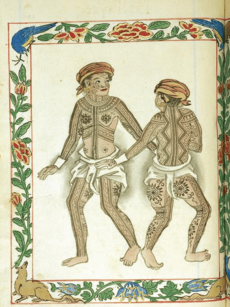
Before the Spanish arrived, Cebu was a local kingdom. Old Visayan stories say it was founded by Sri Lumay, also known as Rajamuda Lumaya. He was half-Malay and half-Tamil from Sumatra. The capital of this kingdom was Singhapala, which means "Lion City" in Tamil-Sanskrit. This is the same origin as the modern city-state of Singapore. The Spanish writer Antonio Pigafetta later mispronounced Singhapala as Cingopola.
Spanish Rule
Magellan's Arrival in 1521
In 1521, the Portuguese explorer Ferdinand Magellan arrived, starting a period of Spanish exploration. Magellan had lost favor with the King of Portugal, so he offered his services to King Charles I of Spain. On September 20, 1519, Magellan set sail from Spain with five ships and 250 people. They reached the Philippines on March 16, 1521.
A local leader, Rajah Kolambu of Mazaua, told them to sail to Cebu to trade and get supplies. In Cebu, Magellan, with Enrique of Malacca as a translator, became friends with Rajah Humabon, a chief in Cebu. Magellan convinced the local people to become allies with the Spanish. On April 14, Magellan put up a large wooden cross on the shores of Cebu. After this, Rajah Humabon and about 400 people from Cebu were baptized.
Magellan soon heard about Datu Lapu-Lapu, a chief on nearby Mactan Island. Lapu-Lapu was a rival of Humabon. On April 27, the Battle of Mactan took place. The Spanish were defeated, and Magellan was killed by the people of Mactan. According to the historian Antonio Pigafetta, Magellan's body was never found. Magellan's second-in-command, Juan Sebastián Elcano, took over and sailed the fleet back to Spain, completing the first trip around the world.
The survivors of Magellan's journey returned to Spain with stories of the islands. Because of this, Spain sent more expeditions, but they all failed for a while.
Legazpi's Expedition in 1565
On April 27, 1565, Miguel López de Legazpi arrived in Cebu. He wanted to make peace but was also ready for a fight, as these were the same people who had killed Magellan 44 years earlier. After some tense moments, the Spanish landed. A crew member found an image of the Child Jesus, which was likely the one Magellan had given to the chief's wife in 1521. A church was built on this spot, which later became the Minor Basilica of the Holy Child.
Twelve days later, on May 8, a fort was built. The local people often attacked during construction, but the Spanish, with their better weapons, always pushed them back. Eventually, the locals gave in. Legazpi made an agreement with Chief Tupas, and peace was established. The Spanish left Cebu on June 1, 1565. By the 1700s, Cebu had many Spanish and native families.
American Rule
In 1898, after the Spanish–American War and Philippine–American War, the island was given to the United States. For a short time in 1901, the United States governed Cebu. However, on February 24, 1937, Cebu became a chartered city and was governed by Filipino politicians.
Japanese Occupation During World War II

Cebu was a key base for the Japanese during their occupation in World War II. Japanese soldiers landed in April 1942. During this time, many people in Cebu faced great difficulties. Filipino and American forces landed in March 1945 and took back the island during the liberation of the Philippines. Cebuano guerrilla groups, led by an American named James M. Cushing, played a big role in helping the combined forces enter Cebu in 1945. The island gained independence from colonial rule in 1946.
Philippine Independence and Recent History
Resistance During the Marcos Era
Cebu became an important center for resisting the Marcos dictatorship. Many Cebuanos were arrested when martial law was declared on September 23, 1972. Prominent figures like writer Resil Mojares and lawyer Democrito Barcenas were detained.
Some people from Cebu, like Redemptorist Priest Fr. Rudy Romano and his colleague Levi Ybañez, disappeared during this time. They were known critics of the Marcos government.
Role in the People Power Revolution
Cebu played a big part in the events leading up to the 1986 People Power revolution, which led to Marcos being removed from power. The Civil Disobedience Campaign against the Marcos government was relaunched from Fuente Osmeña circle in Cebu City on February 22, 1986. During the first day of the People Power revolution, opposition candidates Corazon Aquino and Salvador Laurel found refuge at the Carmelite Monastery in Cebu City.
Modern Cebu
In 2007, the towns of Bogo, Carcar, and Naga became cities. Their city status was challenged but later confirmed by the court on February 15, 2011.
In February 2012, Cebu felt the effects of a strong magnitude 6.7 earthquake from the nearby island of Negros. This was the largest quake in the area in 90 years. Buildings shook, but there was no major damage or loss of life on Cebu Island itself.
In October 2013, Cebu and Bohol were hit by a powerful 7.2 magnitude earthquake. This quake caused 222 deaths and damaged buildings, including five historic churches. A month later, the northern part of the province was hit by Typhoon Haiyan. In December 2021, Typhoon Rai caused widespread damage across the province, leading the government to declare a "calamity."
Cebu's Geography
|
Sugbo
|
|
|---|---|
 |
|
| Geography | |
| Location | Visayas |
| Archipelago | Philippines |
| Adjacent bodies of water |
|
| Area | 4,467.5 km2 (1,724.9 sq mi) |
| Length | 196 km (121.8 mi) |
| Width | 32 km (19.9 mi) |
| Coastline | 513.9 km (319.32 mi) |
| Highest elevation | 1,097 m (3,599 ft) |
| Administration | |
|
Philippines
|
|
| Region | Central Visayas |
| Province | Cebu |
| Demographics | |
| Demonym | Cebuanos (masculine) / Cebuanas (feminine) |
| Population | Expression error: Missing operand for +. (2020 census) |
| Pop. density | Expression error: Unexpected < operator. /km2 (Expression error: Unexpected < operator. /sq mi) |
| Ethnic groups | Visayans (Cebuanos) |
Cebu is located east of Negros and west of Leyte and Bohol islands. The province includes Cebu Island and 167 smaller islands. These include Mactan, Bantayan, Malapascua, Olango, and the Camotes Islands.
The cities of Cebu, Lapu-Lapu, and Mandaue are highly urbanized. This means they are independent cities and not directly controlled by the provincial government. However, they are often grouped with the province for geographical and statistical reasons.
The province's land area is about 4,944 square kilometers (1,909 sq mi). If you include the three independent cities, the total area is about 5,342 square kilometers (2,063 sq mi). Cebu's central location and beautiful natural sites make it a special place. It is also generally safe from major earthquakes and typhoons in its central areas.
Cebu Island's Features
Cebu Island is the 126th largest island in the world. It is long and narrow, stretching 196 kilometers (122 mi) from north to south. At its widest point, it is 32 kilometers (20 mi) across. The island has narrow coastlines, flat limestone areas, and coastal plains. It also has rolling hills and rugged mountains running along its northern and southern parts.
Cebu's highest mountains are over 1,000 meters (3,300 ft) high. Flat areas can be found in the city of Bogo and in the towns of San Remigio, Medellin, and Daanbantayan in the northern part of the province.
The island's area is 4,468 square kilometers (1,725 sq mi). It is the 9th largest island in the Philippines. Over 5.2 million people live on Cebu Island, with about 2.9 million in Metro Cebu. Cebu is surrounded by beaches, coral reefs, and rich fishing grounds.
Coal was first found in Cebu around 1837. Mining operations took place in areas like Naga, Licos, and Camansi. However, serious mining stopped around 1895 due to local uprisings.
Cebu's Climate
Cebu has a tropical climate with two main seasons: dry and wet. It is usually dry and sunny for most of the year. There are some occasional rains from June to December. The province of Cebu typically experiences typhoons once a year or sometimes not at all.
Northern Cebu gets more rainfall and typhoons than southern Cebu due to different climate patterns. Typhoon Haiyan (Yolanda) hit Northern Cebu in 2013, causing 73 deaths and injuring 348 people. While most typhoons affect northern Cebu, central urban areas are sometimes hit. For example, Typhoon Mike (Ruping) hit central Cebu in 1990. In 2021, Typhoon Rai struck the central and southern parts of the province.
Cebu's temperatures can reach 36 °C (97 °F) from March to May. In the mountains, temperatures can drop to 18 °C (64 °F) during the wet season. The average temperature is around 24 to 34 °C (75 to 93 °F). It does not change much, except in May, which is the hottest month. Cebu usually has 70–80% humidity.
Animals of Cebu
Cebu is home to unique animal species found nowhere else. These include the Cebu Flowerpecker (Dicaeum quadricolor), Cebu Slender Skink (Brachymeles cebuensis), Uling Goby (Sicyopus cebuensis), and Black Shama (Copsychus cebuensis).
There is also a special type of butterfly, Idea leuconoe jumaloni, found only in Cebu. It is often called the Kawasan Paper Kite Butterfly because it lives near Kawasan Falls in Badian. This butterfly is named after Julian Jumalon, a Cebuano butterfly expert. It can also be seen in the Nug-as rainforest.
Plants of Cebu
Cebu has very little natural forest left. The remaining forest areas in Cebu mostly have these tree species:
- Mount Lantoy: Carallia brachiata and introduced trees like Tectona grandis, Swietenia macrophylla, Gmelina arborea, and Casuarina equisetifolia.
- Palinipinon Mountains: Carallia brachiata and introduced Swietenia macrophylla.
- Nug-as forest: Ficus species, Artocarpus blancoi, Macaranga grandifolia, and Cinnamomum cebuense.
- Mount Lanaya: Carallia brachiata.
- Mount Tabunan: Trevesia burckii, Voacanga globosa, Heptapleurum actinophyllum, Pouteria villamilii, and Palaquium luzoniense.
Administrative Divisions
The province of Cebu has three highly urbanized cities: Cebu (the capital), Lapu-Lapu, and Mandaue. These cities are geographically part of Cebu but are governed independently. There are also six component cities: Bogo, Carcar, Danao, Naga, Talisay, and Toledo. In addition, Cebu has 44 municipalities, making a total of 53 local government units.
| PSGC | City or Municipality | Population | ±% p.a. | Area | PD | |||||
|---|---|---|---|---|---|---|---|---|---|---|
| 2010 | km2 | sq mi | /km2 | /sq mi | ||||||
| 072201000 | Alcantara † | Expression error: Unexpected * operator.% | 13,556 | Expression error: Missing operand for >. | Expression error: Unexpected < operator.% | Expression error: Unexpected round operator.Expression error: Unexpected round operator.Expression error: Unexpected round operator.Expression error: Unexpected round operator.Expression error: Unexpected round operator.Expression error: Unexpected round operator.Expression error: Unexpected round operator.Expression error: Unexpected round operator.Expression error: Unexpected round operator.Expression error: Unexpected round operator.Expression error: Unexpected round operator.Expression error: Unexpected round operator.Expression error: Unexpected round operator. | Expression error: Unexpected / operator. | Expression error: Unexpected / operator. | Expression error: Unexpected / operator. | |
| 072202000 | Alcoy † | Expression error: Unexpected * operator.% | 14,757 | Expression error: Missing operand for >. | Expression error: Unexpected < operator.% | Expression error: Unexpected round operator.Expression error: Unexpected round operator.Expression error: Unexpected round operator.Expression error: Unexpected round operator.Expression error: Unexpected round operator.Expression error: Unexpected round operator.Expression error: Unexpected round operator.Expression error: Unexpected round operator.Expression error: Unexpected round operator.Expression error: Unexpected round operator.Expression error: Unexpected round operator.Expression error: Unexpected round operator.Expression error: Unexpected round operator. | Expression error: Unexpected / operator. | Expression error: Unexpected / operator. | Expression error: Unexpected / operator. | |
| 072203000 | Alegria † | Expression error: Unexpected * operator.% | 22,072 | Expression error: Missing operand for >. | Expression error: Unexpected < operator.% | Expression error: Unexpected round operator.Expression error: Unexpected round operator.Expression error: Unexpected round operator.Expression error: Unexpected round operator.Expression error: Unexpected round operator.Expression error: Unexpected round operator.Expression error: Unexpected round operator.Expression error: Unexpected round operator.Expression error: Unexpected round operator.Expression error: Unexpected round operator.Expression error: Unexpected round operator.Expression error: Unexpected round operator.Expression error: Unexpected round operator. | Expression error: Unexpected / operator. | Expression error: Unexpected / operator. | Expression error: Unexpected / operator. | |
| 072204000 | Aloguinsan † | Expression error: Unexpected * operator.% | 27,650 | Expression error: Missing operand for >. | Expression error: Unexpected < operator.% | Expression error: Unexpected round operator.Expression error: Unexpected round operator.Expression error: Unexpected round operator.Expression error: Unexpected round operator.Expression error: Unexpected round operator.Expression error: Unexpected round operator.Expression error: Unexpected round operator.Expression error: Unexpected round operator.Expression error: Unexpected round operator.Expression error: Unexpected round operator.Expression error: Unexpected round operator.Expression error: Unexpected round operator.Expression error: Unexpected round operator. | Expression error: Unexpected / operator. | Expression error: Unexpected / operator. | Expression error: Unexpected / operator. | |
| 072205000 | Argao † | Expression error: Unexpected * operator.% | 69,503 | Expression error: Missing operand for >. | Expression error: Unexpected < operator.% | Expression error: Unexpected round operator.Expression error: Unexpected round operator.Expression error: Unexpected round operator.Expression error: Unexpected round operator.Expression error: Unexpected round operator.Expression error: Unexpected round operator.Expression error: Unexpected round operator.Expression error: Unexpected round operator.Expression error: Unexpected round operator.Expression error: Unexpected round operator.Expression error: Unexpected round operator.Expression error: Unexpected round operator.Expression error: Unexpected round operator. | Expression error: Unexpected / operator. | Expression error: Unexpected / operator. | Expression error: Unexpected / operator. | |
| 072206000 | Asturias † | Expression error: Unexpected * operator.% | 44,732 | Expression error: Missing operand for >. | Expression error: Unexpected < operator.% | Expression error: Unexpected round operator.Expression error: Unexpected round operator.Expression error: Unexpected round operator.Expression error: Unexpected round operator.Expression error: Unexpected round operator.Expression error: Unexpected round operator.Expression error: Unexpected round operator.Expression error: Unexpected round operator.Expression error: Unexpected round operator.Expression error: Unexpected round operator.Expression error: Unexpected round operator.Expression error: Unexpected round operator.Expression error: Unexpected round operator. | Expression error: Unexpected / operator. | Expression error: Unexpected / operator. | Expression error: Unexpected / operator. | |
| 072207000 | Badian † | Expression error: Unexpected * operator.% | 37,699 | Expression error: Missing operand for >. | Expression error: Unexpected < operator.% | Expression error: Unexpected round operator.Expression error: Unexpected round operator.Expression error: Unexpected round operator.Expression error: Unexpected round operator.Expression error: Unexpected round operator.Expression error: Unexpected round operator.Expression error: Unexpected round operator.Expression error: Unexpected round operator.Expression error: Unexpected round operator.Expression error: Unexpected round operator.Expression error: Unexpected round operator.Expression error: Unexpected round operator.Expression error: Unexpected round operator. | Expression error: Unexpected / operator. | Expression error: Unexpected / operator. | Expression error: Unexpected / operator. | |
| 072208000 | Balamban † | Expression error: Unexpected * operator.% | 71,237 | Expression error: Missing operand for >. | Expression error: Unexpected < operator.% | Expression error: Unexpected round operator.Expression error: Unexpected round operator.Expression error: Unexpected round operator.Expression error: Unexpected round operator.Expression error: Unexpected round operator.Expression error: Unexpected round operator.Expression error: Unexpected round operator.Expression error: Unexpected round operator.Expression error: Unexpected round operator.Expression error: Unexpected round operator.Expression error: Unexpected round operator.Expression error: Unexpected round operator.Expression error: Unexpected round operator. | Expression error: Unexpected / operator. | Expression error: Unexpected / operator. | Expression error: Unexpected / operator. | |
| 072209000 | Bantayan † | Expression error: Unexpected * operator.% | 74,785 | Expression error: Missing operand for >. | Expression error: Unexpected < operator.% | Expression error: Unexpected round operator.Expression error: Unexpected round operator.Expression error: Unexpected round operator.Expression error: Unexpected round operator.Expression error: Unexpected round operator.Expression error: Unexpected round operator.Expression error: Unexpected round operator.Expression error: Unexpected round operator.Expression error: Unexpected round operator.Expression error: Unexpected round operator.Expression error: Unexpected round operator.Expression error: Unexpected round operator.Expression error: Unexpected round operator. | Expression error: Unexpected / operator. | Expression error: Unexpected / operator. | Expression error: Unexpected / operator. | |
| 072210000 | Barili † | Expression error: Unexpected * operator.% | 65,524 | Expression error: Missing operand for >. | Expression error: Unexpected < operator.% | Expression error: Unexpected round operator.Expression error: Unexpected round operator.Expression error: Unexpected round operator.Expression error: Unexpected round operator.Expression error: Unexpected round operator.Expression error: Unexpected round operator.Expression error: Unexpected round operator.Expression error: Unexpected round operator.Expression error: Unexpected round operator.Expression error: Unexpected round operator.Expression error: Unexpected round operator.Expression error: Unexpected round operator.Expression error: Unexpected round operator. | Expression error: Unexpected / operator. | Expression error: Unexpected / operator. | Expression error: Unexpected / operator. | |
| 072211000 | Bogo † | Expression error: Unexpected * operator.% | 69,911 | Expression error: Missing operand for >. | Expression error: Unexpected < operator.% | Expression error: Unexpected round operator.Expression error: Unexpected round operator.Expression error: Unexpected round operator.Expression error: Unexpected round operator.Expression error: Unexpected round operator.Expression error: Unexpected round operator.Expression error: Unexpected round operator.Expression error: Unexpected round operator.Expression error: Unexpected round operator.Expression error: Unexpected round operator.Expression error: Unexpected round operator.Expression error: Unexpected round operator.Expression error: Unexpected round operator. | Expression error: Unexpected / operator. | Expression error: Unexpected / operator. | Expression error: Unexpected / operator. | |
| 072212000 | Boljoon † | Expression error: Unexpected * operator.% | 14,877 | Expression error: Missing operand for >. | Expression error: Unexpected < operator.% | Expression error: Unexpected round operator.Expression error: Unexpected round operator.Expression error: Unexpected round operator.Expression error: Unexpected round operator.Expression error: Unexpected round operator.Expression error: Unexpected round operator.Expression error: Unexpected round operator.Expression error: Unexpected round operator.Expression error: Unexpected round operator.Expression error: Unexpected round operator.Expression error: Unexpected round operator.Expression error: Unexpected round operator.Expression error: Unexpected round operator. | Expression error: Unexpected / operator. | Expression error: Unexpected / operator. | Expression error: Unexpected / operator. | |
| 072213000 | Borbon † | Expression error: Unexpected * operator.% | 32,278 | Expression error: Missing operand for >. | Expression error: Unexpected < operator.% | Expression error: Unexpected round operator.Expression error: Unexpected round operator.Expression error: Unexpected round operator.Expression error: Unexpected round operator.Expression error: Unexpected round operator.Expression error: Unexpected round operator.Expression error: Unexpected round operator.Expression error: Unexpected round operator.Expression error: Unexpected round operator.Expression error: Unexpected round operator.Expression error: Unexpected round operator.Expression error: Unexpected round operator.Expression error: Unexpected round operator. | Expression error: Unexpected / operator. | Expression error: Unexpected / operator. | Expression error: Unexpected / operator. | |
| 072214000 | Carcar † | Expression error: Unexpected * operator.% | 100,632 | Expression error: Missing operand for >. | Expression error: Unexpected < operator.% | Expression error: Unexpected round operator.Expression error: Unexpected round operator.Expression error: Unexpected round operator.Expression error: Unexpected round operator.Expression error: Unexpected round operator.Expression error: Unexpected round operator.Expression error: Unexpected round operator.Expression error: Unexpected round operator.Expression error: Unexpected round operator.Expression error: Unexpected round operator.Expression error: Unexpected round operator.Expression error: Unexpected round operator.Expression error: Unexpected round operator. | Expression error: Unexpected / operator. | Expression error: Unexpected / operator. | Expression error: Unexpected / operator. | |
| 072215000 | Carmen † | Expression error: Unexpected * operator.% | 41,279 | Expression error: Missing operand for >. | Expression error: Unexpected < operator.% | Expression error: Unexpected round operator.Expression error: Unexpected round operator.Expression error: Unexpected round operator.Expression error: Unexpected round operator.Expression error: Unexpected round operator.Expression error: Unexpected round operator.Expression error: Unexpected round operator.Expression error: Unexpected round operator.Expression error: Unexpected round operator.Expression error: Unexpected round operator.Expression error: Unexpected round operator.Expression error: Unexpected round operator.Expression error: Unexpected round operator. | Expression error: Unexpected / operator. | Expression error: Unexpected / operator. | Expression error: Unexpected / operator. | |
| 072216000 | Catmon † | Expression error: Unexpected * operator.% | 27,330 | Expression error: Missing operand for >. | Expression error: Unexpected < operator.% | Expression error: Unexpected round operator.Expression error: Unexpected round operator.Expression error: Unexpected round operator.Expression error: Unexpected round operator.Expression error: Unexpected round operator.Expression error: Unexpected round operator.Expression error: Unexpected round operator.Expression error: Unexpected round operator.Expression error: Unexpected round operator.Expression error: Unexpected round operator.Expression error: Unexpected round operator.Expression error: Unexpected round operator.Expression error: Unexpected round operator. | Expression error: Unexpected / operator. | Expression error: Unexpected / operator. | Expression error: Unexpected / operator. | |
| 072217000 | Cebu City∞ † | Expression error: Unexpected * operator.% | 866,171 | Expression error: Missing operand for >. | Expression error: Unexpected < operator.% | Expression error: Unexpected round operator.Expression error: Unexpected round operator.Expression error: Unexpected round operator.Expression error: Unexpected round operator.Expression error: Unexpected round operator.Expression error: Unexpected round operator.Expression error: Unexpected round operator.Expression error: Unexpected round operator.Expression error: Unexpected round operator.Expression error: Unexpected round operator.Expression error: Unexpected round operator.Expression error: Unexpected round operator.Expression error: Unexpected round operator. | Expression error: Unexpected / operator. | Expression error: Unexpected / operator. | Expression error: Unexpected / operator. | |
| 072218000 | Compostela † | Expression error: Unexpected * operator.% | 39,167 | Expression error: Missing operand for >. | Expression error: Unexpected < operator.% | Expression error: Unexpected round operator.Expression error: Unexpected round operator.Expression error: Unexpected round operator.Expression error: Unexpected round operator.Expression error: Unexpected round operator.Expression error: Unexpected round operator.Expression error: Unexpected round operator.Expression error: Unexpected round operator.Expression error: Unexpected round operator.Expression error: Unexpected round operator.Expression error: Unexpected round operator.Expression error: Unexpected round operator.Expression error: Unexpected round operator. | Expression error: Unexpected / operator. | Expression error: Unexpected / operator. | Expression error: Unexpected / operator. | |
| 072219000 | Consolacion † | Expression error: Unexpected * operator.% | 106,649 | Expression error: Missing operand for >. | Expression error: Unexpected < operator.% | Expression error: Unexpected round operator.Expression error: Unexpected round operator.Expression error: Unexpected round operator.Expression error: Unexpected round operator.Expression error: Unexpected round operator.Expression error: Unexpected round operator.Expression error: Unexpected round operator.Expression error: Unexpected round operator.Expression error: Unexpected round operator.Expression error: Unexpected round operator.Expression error: Unexpected round operator.Expression error: Unexpected round operator.Expression error: Unexpected round operator. | Expression error: Unexpected / operator. | Expression error: Unexpected / operator. | Expression error: Unexpected / operator. | |
| 072220000 | Cordova † | Expression error: Unexpected * operator.% | 50,353 | Expression error: Missing operand for >. | Expression error: Unexpected < operator.% | Expression error: Unexpected round operator.Expression error: Unexpected round operator.Expression error: Unexpected round operator.Expression error: Unexpected round operator.Expression error: Unexpected round operator.Expression error: Unexpected round operator.Expression error: Unexpected round operator.Expression error: Unexpected round operator.Expression error: Unexpected round operator.Expression error: Unexpected round operator.Expression error: Unexpected round operator.Expression error: Unexpected round operator.Expression error: Unexpected round operator. | Expression error: Unexpected / operator. | Expression error: Unexpected / operator. | Expression error: Unexpected / operator. | |
| 072221000 | Daanbantayan † | Expression error: Unexpected * operator.% | 74,897 | Expression error: Missing operand for >. | Expression error: Unexpected < operator.% | Expression error: Unexpected round operator.Expression error: Unexpected round operator.Expression error: Unexpected round operator.Expression error: Unexpected round operator.Expression error: Unexpected round operator.Expression error: Unexpected round operator.Expression error: Unexpected round operator.Expression error: Unexpected round operator.Expression error: Unexpected round operator.Expression error: Unexpected round operator.Expression error: Unexpected round operator.Expression error: Unexpected round operator.Expression error: Unexpected round operator. | Expression error: Unexpected / operator. | Expression error: Unexpected / operator. | Expression error: Unexpected / operator. | |
| 072222000 | Dalaguete † | Expression error: Unexpected * operator.% | 63,239 | Expression error: Missing operand for >. | Expression error: Unexpected < operator.% | Expression error: Unexpected round operator.Expression error: Unexpected round operator.Expression error: Unexpected round operator.Expression error: Unexpected round operator.Expression error: Unexpected round operator.Expression error: Unexpected round operator.Expression error: Unexpected round operator.Expression error: Unexpected round operator.Expression error: Unexpected round operator.Expression error: Unexpected round operator.Expression error: Unexpected round operator.Expression error: Unexpected round operator.Expression error: Unexpected round operator. | Expression error: Unexpected / operator. | Expression error: Unexpected / operator. | Expression error: Unexpected / operator. | |
| 072223000 | Danao † | Expression error: Unexpected * operator.% | 119,252 | Expression error: Missing operand for >. | Expression error: Unexpected < operator.% | Expression error: Unexpected round operator.Expression error: Unexpected round operator.Expression error: Unexpected round operator.Expression error: Unexpected round operator.Expression error: Unexpected round operator.Expression error: Unexpected round operator.Expression error: Unexpected round operator.Expression error: Unexpected round operator.Expression error: Unexpected round operator.Expression error: Unexpected round operator.Expression error: Unexpected round operator.Expression error: Unexpected round operator.Expression error: Unexpected round operator. | Expression error: Unexpected / operator. | Expression error: Unexpected / operator. | Expression error: Unexpected / operator. | |
| 072224000 | Dumanjug † | Expression error: Unexpected * operator.% | 46,754 | Expression error: Missing operand for >. | Expression error: Unexpected < operator.% | Expression error: Unexpected round operator.Expression error: Unexpected round operator.Expression error: Unexpected round operator.Expression error: Unexpected round operator.Expression error: Unexpected round operator.Expression error: Unexpected round operator.Expression error: Unexpected round operator.Expression error: Unexpected round operator.Expression error: Unexpected round operator.Expression error: Unexpected round operator.Expression error: Unexpected round operator.Expression error: Unexpected round operator.Expression error: Unexpected round operator. | Expression error: Unexpected / operator. | Expression error: Unexpected / operator. | Expression error: Unexpected / operator. | |
| 072225000 | Ginatilan † | Expression error: Unexpected * operator.% | 15,327 | Expression error: Missing operand for >. | Expression error: Unexpected < operator.% | Expression error: Unexpected round operator.Expression error: Unexpected round operator.Expression error: Unexpected round operator.Expression error: Unexpected round operator.Expression error: Unexpected round operator.Expression error: Unexpected round operator.Expression error: Unexpected round operator.Expression error: Unexpected round operator.Expression error: Unexpected round operator.Expression error: Unexpected round operator.Expression error: Unexpected round operator.Expression error: Unexpected round operator.Expression error: Unexpected round operator. | Expression error: Unexpected / operator. | Expression error: Unexpected / operator. | Expression error: Unexpected / operator. | |
| 072226000 | Lapu-Lapu City † | Expression error: Unexpected * operator.% | 350,467 | Expression error: Missing operand for >. | Expression error: Unexpected < operator.% | Expression error: Unexpected round operator.Expression error: Unexpected round operator.Expression error: Unexpected round operator.Expression error: Unexpected round operator.Expression error: Unexpected round operator.Expression error: Unexpected round operator.Expression error: Unexpected round operator.Expression error: Unexpected round operator.Expression error: Unexpected round operator.Expression error: Unexpected round operator.Expression error: Unexpected round operator.Expression error: Unexpected round operator.Expression error: Unexpected round operator. | Expression error: Unexpected / operator. | Expression error: Unexpected / operator. | Expression error: Unexpected / operator. | |
| 072227000 | Liloan † | Expression error: Unexpected * operator.% | 100,500 | Expression error: Missing operand for >. | Expression error: Unexpected < operator.% | Expression error: Unexpected round operator.Expression error: Unexpected round operator.Expression error: Unexpected round operator.Expression error: Unexpected round operator.Expression error: Unexpected round operator.Expression error: Unexpected round operator.Expression error: Unexpected round operator.Expression error: Unexpected round operator.Expression error: Unexpected round operator.Expression error: Unexpected round operator.Expression error: Unexpected round operator.Expression error: Unexpected round operator.Expression error: Unexpected round operator. | Expression error: Unexpected / operator. | Expression error: Unexpected / operator. | Expression error: Unexpected / operator. | |
| 072228000 | Madridejos † | Expression error: Unexpected * operator.% | 34,905 | Expression error: Missing operand for >. | Expression error: Unexpected < operator.% | Expression error: Unexpected round operator.Expression error: Unexpected round operator.Expression error: Unexpected round operator.Expression error: Unexpected round operator.Expression error: Unexpected round operator.Expression error: Unexpected round operator.Expression error: Unexpected round operator.Expression error: Unexpected round operator.Expression error: Unexpected round operator.Expression error: Unexpected round operator.Expression error: Unexpected round operator.Expression error: Unexpected round operator.Expression error: Unexpected round operator. | Expression error: Unexpected / operator. | Expression error: Unexpected / operator. | Expression error: Unexpected / operator. | |
| 072229000 | Malabuyoc † | Expression error: Unexpected * operator.% | 18,426 | Expression error: Missing operand for >. | Expression error: Unexpected < operator.% | Expression error: Unexpected round operator.Expression error: Unexpected round operator.Expression error: Unexpected round operator.Expression error: Unexpected round operator.Expression error: Unexpected round operator.Expression error: Unexpected round operator.Expression error: Unexpected round operator.Expression error: Unexpected round operator.Expression error: Unexpected round operator.Expression error: Unexpected round operator.Expression error: Unexpected round operator.Expression error: Unexpected round operator.Expression error: Unexpected round operator. | Expression error: Unexpected / operator. | Expression error: Unexpected / operator. | Expression error: Unexpected / operator. | |
| 072230000 | Mandaue † | Expression error: Unexpected * operator.% | 331,320 | Expression error: Missing operand for >. | Expression error: Unexpected < operator.% | Expression error: Unexpected round operator.Expression error: Unexpected round operator.Expression error: Unexpected round operator.Expression error: Unexpected round operator.Expression error: Unexpected round operator.Expression error: Unexpected round operator.Expression error: Unexpected round operator.Expression error: Unexpected round operator.Expression error: Unexpected round operator.Expression error: Unexpected round operator.Expression error: Unexpected round operator.Expression error: Unexpected round operator.Expression error: Unexpected round operator. | Expression error: Unexpected / operator. | Expression error: Unexpected / operator. | Expression error: Unexpected / operator. | |
| 072231000 | Medellin † | Expression error: Unexpected * operator.% | 50,047 | Expression error: Missing operand for >. | Expression error: Unexpected < operator.% | Expression error: Unexpected round operator.Expression error: Unexpected round operator.Expression error: Unexpected round operator.Expression error: Unexpected round operator.Expression error: Unexpected round operator.Expression error: Unexpected round operator.Expression error: Unexpected round operator.Expression error: Unexpected round operator.Expression error: Unexpected round operator.Expression error: Unexpected round operator.Expression error: Unexpected round operator.Expression error: Unexpected round operator.Expression error: Unexpected round operator. | Expression error: Unexpected / operator. | Expression error: Unexpected / operator. | Expression error: Unexpected / operator. | |
| 072232000 | Minglanilla † | Expression error: Unexpected * operator.% | 113,178 | Expression error: Missing operand for >. | Expression error: Unexpected < operator.% | Expression error: Unexpected round operator.Expression error: Unexpected round operator.Expression error: Unexpected round operator.Expression error: Unexpected round operator.Expression error: Unexpected round operator.Expression error: Unexpected round operator.Expression error: Unexpected round operator.Expression error: Unexpected round operator.Expression error: Unexpected round operator.Expression error: Unexpected round operator.Expression error: Unexpected round operator.Expression error: Unexpected round operator.Expression error: Unexpected round operator. | Expression error: Unexpected / operator. | Expression error: Unexpected / operator. | Expression error: Unexpected / operator. | |
| 072233000 | Moalboal † | Expression error: Unexpected * operator.% | 27,676 | Expression error: Missing operand for >. | Expression error: Unexpected < operator.% | Expression error: Unexpected round operator.Expression error: Unexpected round operator.Expression error: Unexpected round operator.Expression error: Unexpected round operator.Expression error: Unexpected round operator.Expression error: Unexpected round operator.Expression error: Unexpected round operator.Expression error: Unexpected round operator.Expression error: Unexpected round operator.Expression error: Unexpected round operator.Expression error: Unexpected round operator.Expression error: Unexpected round operator.Expression error: Unexpected round operator. | Expression error: Unexpected / operator. | Expression error: Unexpected / operator. | Expression error: Unexpected / operator. | |
| 072234000 | Naga † | Expression error: Unexpected * operator.% | 101,571 | Expression error: Missing operand for >. | Expression error: Unexpected < operator.% | Expression error: Unexpected round operator.Expression error: Unexpected round operator.Expression error: Unexpected round operator.Expression error: Unexpected round operator.Expression error: Unexpected round operator.Expression error: Unexpected round operator.Expression error: Unexpected round operator.Expression error: Unexpected round operator.Expression error: Unexpected round operator.Expression error: Unexpected round operator.Expression error: Unexpected round operator.Expression error: Unexpected round operator.Expression error: Unexpected round operator. | Expression error: Unexpected / operator. | Expression error: Unexpected / operator. | Expression error: Unexpected / operator. | |
| 072235000 | Oslob † | Expression error: Unexpected * operator.% | 26,116 | Expression error: Missing operand for >. | Expression error: Unexpected < operator.% | Expression error: Unexpected round operator.Expression error: Unexpected round operator.Expression error: Unexpected round operator.Expression error: Unexpected round operator.Expression error: Unexpected round operator.Expression error: Unexpected round operator.Expression error: Unexpected round operator.Expression error: Unexpected round operator.Expression error: Unexpected round operator.Expression error: Unexpected round operator.Expression error: Unexpected round operator.Expression error: Unexpected round operator.Expression error: Unexpected round operator. | Expression error: Unexpected / operator. | Expression error: Unexpected / operator. | Expression error: Unexpected / operator. | |
| 072236000 | Pilar † | Expression error: Unexpected * operator.% | 11,564 | Expression error: Missing operand for >. | Expression error: Unexpected < operator.% | Expression error: Unexpected round operator.Expression error: Unexpected round operator.Expression error: Unexpected round operator.Expression error: Unexpected round operator.Expression error: Unexpected round operator.Expression error: Unexpected round operator.Expression error: Unexpected round operator.Expression error: Unexpected round operator.Expression error: Unexpected round operator.Expression error: Unexpected round operator.Expression error: Unexpected round operator.Expression error: Unexpected round operator.Expression error: Unexpected round operator. | Expression error: Unexpected / operator. | Expression error: Unexpected / operator. | Expression error: Unexpected / operator. | |
| 072237000 | Pinamungajan † | Expression error: Unexpected * operator.% | 57,997 | Expression error: Missing operand for >. | Expression error: Unexpected < operator.% | Expression error: Unexpected round operator.Expression error: Unexpected round operator.Expression error: Unexpected round operator.Expression error: Unexpected round operator.Expression error: Unexpected round operator.Expression error: Unexpected round operator.Expression error: Unexpected round operator.Expression error: Unexpected round operator.Expression error: Unexpected round operator.Expression error: Unexpected round operator.Expression error: Unexpected round operator.Expression error: Unexpected round operator.Expression error: Unexpected round operator. | Expression error: Unexpected / operator. | Expression error: Unexpected / operator. | Expression error: Unexpected / operator. | |
| 072238000 | Poro † | Expression error: Unexpected * operator.% | 23,498 | Expression error: Missing operand for >. | Expression error: Unexpected < operator.% | Expression error: Unexpected round operator.Expression error: Unexpected round operator.Expression error: Unexpected round operator.Expression error: Unexpected round operator.Expression error: Unexpected round operator.Expression error: Unexpected round operator.Expression error: Unexpected round operator.Expression error: Unexpected round operator.Expression error: Unexpected round operator.Expression error: Unexpected round operator.Expression error: Unexpected round operator.Expression error: Unexpected round operator.Expression error: Unexpected round operator. | Expression error: Unexpected / operator. | Expression error: Unexpected / operator. | Expression error: Unexpected / operator. | |
| 072239000 | Ronda † | Expression error: Unexpected * operator.% | 18,582 | Expression error: Missing operand for >. | Expression error: Unexpected < operator.% | Expression error: Unexpected round operator.Expression error: Unexpected round operator.Expression error: Unexpected round operator.Expression error: Unexpected round operator.Expression error: Unexpected round operator.Expression error: Unexpected round operator.Expression error: Unexpected round operator.Expression error: Unexpected round operator.Expression error: Unexpected round operator.Expression error: Unexpected round operator.Expression error: Unexpected round operator.Expression error: Unexpected round operator.Expression error: Unexpected round operator. | Expression error: Unexpected / operator. | Expression error: Unexpected / operator. | Expression error: Unexpected / operator. | |
| 072240000 | Samboan † | Expression error: Unexpected * operator.% | 18,613 | Expression error: Missing operand for >. | Expression error: Unexpected < operator.% | Expression error: Unexpected round operator.Expression error: Unexpected round operator.Expression error: Unexpected round operator.Expression error: Unexpected round operator.Expression error: Unexpected round operator.Expression error: Unexpected round operator.Expression error: Unexpected round operator.Expression error: Unexpected round operator.Expression error: Unexpected round operator.Expression error: Unexpected round operator.Expression error: Unexpected round operator.Expression error: Unexpected round operator.Expression error: Unexpected round operator. | Expression error: Unexpected / operator. | Expression error: Unexpected / operator. | Expression error: Unexpected / operator. | |
| 072241000 | San Fernando † | Expression error: Unexpected * operator.% | 60,970 | Expression error: Missing operand for >. | Expression error: Unexpected < operator.% | Expression error: Unexpected round operator.Expression error: Unexpected round operator.Expression error: Unexpected round operator.Expression error: Unexpected round operator.Expression error: Unexpected round operator.Expression error: Unexpected round operator.Expression error: Unexpected round operator.Expression error: Unexpected round operator.Expression error: Unexpected round operator.Expression error: Unexpected round operator.Expression error: Unexpected round operator.Expression error: Unexpected round operator.Expression error: Unexpected round operator. | Expression error: Unexpected / operator. | Expression error: Unexpected / operator. | Expression error: Unexpected / operator. | |
| 072242000 | San Francisco † | Expression error: Unexpected * operator.% | 47,357 | Expression error: Missing operand for >. | Expression error: Unexpected < operator.% | Expression error: Unexpected round operator.Expression error: Unexpected round operator.Expression error: Unexpected round operator.Expression error: Unexpected round operator.Expression error: Unexpected round operator.Expression error: Unexpected round operator.Expression error: Unexpected round operator.Expression error: Unexpected round operator.Expression error: Unexpected round operator.Expression error: Unexpected round operator.Expression error: Unexpected round operator.Expression error: Unexpected round operator.Expression error: Unexpected round operator. | Expression error: Unexpected / operator. | Expression error: Unexpected / operator. | Expression error: Unexpected / operator. | |
| 072243000 | San Remigio † | Expression error: Unexpected * operator.% | 51,394 | Expression error: Missing operand for >. | Expression error: Unexpected < operator.% | Expression error: Unexpected round operator.Expression error: Unexpected round operator.Expression error: Unexpected round operator.Expression error: Unexpected round operator.Expression error: Unexpected round operator.Expression error: Unexpected round operator.Expression error: Unexpected round operator.Expression error: Unexpected round operator.Expression error: Unexpected round operator.Expression error: Unexpected round operator.Expression error: Unexpected round operator.Expression error: Unexpected round operator.Expression error: Unexpected round operator. | Expression error: Unexpected / operator. | Expression error: Unexpected / operator. | Expression error: Unexpected / operator. | |
| 072244000 | Santa Fe † | Expression error: Unexpected * operator.% | 27,270 | Expression error: Missing operand for >. | Expression error: Unexpected < operator.% | Expression error: Unexpected round operator.Expression error: Unexpected round operator.Expression error: Unexpected round operator.Expression error: Unexpected round operator.Expression error: Unexpected round operator.Expression error: Unexpected round operator.Expression error: Unexpected round operator.Expression error: Unexpected round operator.Expression error: Unexpected round operator.Expression error: Unexpected round operator.Expression error: Unexpected round operator.Expression error: Unexpected round operator.Expression error: Unexpected round operator. | Expression error: Unexpected / operator. | Expression error: Unexpected / operator. | Expression error: Unexpected / operator. | |
| 072245000 | Santander † | Expression error: Unexpected * operator.% | 16,105 | Expression error: Missing operand for >. | Expression error: Unexpected < operator.% | Expression error: Unexpected round operator.Expression error: Unexpected round operator.Expression error: Unexpected round operator.Expression error: Unexpected round operator.Expression error: Unexpected round operator.Expression error: Unexpected round operator.Expression error: Unexpected round operator.Expression error: Unexpected round operator.Expression error: Unexpected round operator.Expression error: Unexpected round operator.Expression error: Unexpected round operator.Expression error: Unexpected round operator.Expression error: Unexpected round operator. | Expression error: Unexpected / operator. | Expression error: Unexpected / operator. | Expression error: Unexpected / operator. | |
| 072246000 | Sibonga † | Expression error: Unexpected * operator.% | 43,641 | Expression error: Missing operand for >. | Expression error: Unexpected < operator.% | Expression error: Unexpected round operator.Expression error: Unexpected round operator.Expression error: Unexpected round operator.Expression error: Unexpected round operator.Expression error: Unexpected round operator.Expression error: Unexpected round operator.Expression error: Unexpected round operator.Expression error: Unexpected round operator.Expression error: Unexpected round operator.Expression error: Unexpected round operator.Expression error: Unexpected round operator.Expression error: Unexpected round operator.Expression error: Unexpected round operator. | Expression error: Unexpected / operator. | Expression error: Unexpected / operator. | Expression error: Unexpected / operator. | |
| 072247000 | Sogod † | Expression error: Unexpected * operator.% | 30,626 | Expression error: Missing operand for >. | Expression error: Unexpected < operator.% | Expression error: Unexpected round operator.Expression error: Unexpected round operator.Expression error: Unexpected round operator.Expression error: Unexpected round operator.Expression error: Unexpected round operator.Expression error: Unexpected round operator.Expression error: Unexpected round operator.Expression error: Unexpected round operator.Expression error: Unexpected round operator.Expression error: Unexpected round operator.Expression error: Unexpected round operator.Expression error: Unexpected round operator.Expression error: Unexpected round operator. | Expression error: Unexpected / operator. | Expression error: Unexpected / operator. | Expression error: Unexpected / operator. | |
| 072248000 | Tabogon † | Expression error: Unexpected * operator.% | 33,024 | Expression error: Missing operand for >. | Expression error: Unexpected < operator.% | Expression error: Unexpected round operator.Expression error: Unexpected round operator.Expression error: Unexpected round operator.Expression error: Unexpected round operator.Expression error: Unexpected round operator.Expression error: Unexpected round operator.Expression error: Unexpected round operator.Expression error: Unexpected round operator.Expression error: Unexpected round operator.Expression error: Unexpected round operator.Expression error: Unexpected round operator.Expression error: Unexpected round operator.Expression error: Unexpected round operator. | Expression error: Unexpected / operator. | Expression error: Unexpected / operator. | Expression error: Unexpected / operator. | |
| 072249000 | Tabuelan † | Expression error: Unexpected * operator.% | 22,292 | Expression error: Missing operand for >. | Expression error: Unexpected < operator.% | Expression error: Unexpected round operator.Expression error: Unexpected round operator.Expression error: Unexpected round operator.Expression error: Unexpected round operator.Expression error: Unexpected round operator.Expression error: Unexpected round operator.Expression error: Unexpected round operator.Expression error: Unexpected round operator.Expression error: Unexpected round operator.Expression error: Unexpected round operator.Expression error: Unexpected round operator.Expression error: Unexpected round operator.Expression error: Unexpected round operator. | Expression error: Unexpected / operator. | Expression error: Unexpected / operator. | Expression error: Unexpected / operator. | |
| 072250000 | Talisay † | Expression error: Unexpected * operator.% | 200,772 | Expression error: Missing operand for >. | Expression error: Unexpected < operator.% | Expression error: Unexpected round operator.Expression error: Unexpected round operator.Expression error: Unexpected round operator.Expression error: Unexpected round operator.Expression error: Unexpected round operator.Expression error: Unexpected round operator.Expression error: Unexpected round operator.Expression error: Unexpected round operator.Expression error: Unexpected round operator.Expression error: Unexpected round operator.Expression error: Unexpected round operator.Expression error: Unexpected round operator.Expression error: Unexpected round operator. | Expression error: Unexpected / operator. | Expression error: Unexpected / operator. | Expression error: Unexpected / operator. | |
| 072251000 | Toledo † | Expression error: Unexpected * operator.% | 157,078 | Expression error: Missing operand for >. | Expression error: Unexpected < operator.% | Expression error: Unexpected round operator.Expression error: Unexpected round operator.Expression error: Unexpected round operator.Expression error: Unexpected round operator.Expression error: Unexpected round operator.Expression error: Unexpected round operator.Expression error: Unexpected round operator.Expression error: Unexpected round operator.Expression error: Unexpected round operator.Expression error: Unexpected round operator.Expression error: Unexpected round operator.Expression error: Unexpected round operator.Expression error: Unexpected round operator. | Expression error: Unexpected / operator. | Expression error: Unexpected / operator. | Expression error: Unexpected / operator. | |
| 072252000 | Tuburan † | Expression error: Unexpected * operator.% | 58,914 | Expression error: Missing operand for >. | Expression error: Unexpected < operator.% | Expression error: Unexpected round operator.Expression error: Unexpected round operator.Expression error: Unexpected round operator.Expression error: Unexpected round operator.Expression error: Unexpected round operator.Expression error: Unexpected round operator.Expression error: Unexpected round operator.Expression error: Unexpected round operator.Expression error: Unexpected round operator.Expression error: Unexpected round operator.Expression error: Unexpected round operator.Expression error: Unexpected round operator.Expression error: Unexpected round operator. | Expression error: Unexpected / operator. | Expression error: Unexpected / operator. | Expression error: Unexpected / operator. | |
| 072253000 | Tudela † | Expression error: Unexpected * operator.% | 9,859 | Expression error: Missing operand for >. | Expression error: Unexpected < operator.% | Expression error: Unexpected round operator.Expression error: Unexpected round operator.Expression error: Unexpected round operator.Expression error: Unexpected round operator.Expression error: Unexpected round operator.Expression error: Unexpected round operator.Expression error: Unexpected round operator.Expression error: Unexpected round operator.Expression error: Unexpected round operator.Expression error: Unexpected round operator.Expression error: Unexpected round operator.Expression error: Unexpected round operator.Expression error: Unexpected round operator. | Expression error: Unexpected / operator. | Expression error: Unexpected / operator. | Expression error: Unexpected / operator. | |
| TOTAL | 2,619,362 | Expression error: Missing operand for >. | Expression error: Unexpected < operator.% | Expression error: Unexpected round operator.Expression error: Unexpected round operator.Expression error: Unexpected round operator.Expression error: Unexpected round operator.Expression error: Unexpected round operator.Expression error: Unexpected round operator.Expression error: Unexpected round operator.Expression error: Unexpected round operator.Expression error: Unexpected round operator.Expression error: Unexpected round operator.Expression error: Unexpected round operator.Expression error: Unexpected round operator.Expression error: Unexpected round operator. | Expression error: Unexpected / operator.Expression error: Unexpected / operator.Expression error: Unexpected / operator.Expression error: Unexpected / operator.Expression error: Unexpected / operator.Expression error: Unexpected / operator.Expression error: Unexpected / operator.Expression error: Unexpected / operator.Expression error: Unexpected / operator.Expression error: Unexpected / operator.Expression error: Unexpected / operator.Expression error: Unexpected / operator.Expression error: Unexpected / operator. | Expression error: Unexpected / operator. | Expression error: Unexpected < operator. | |||
| † Provincial capital Highly Urbanized City Municipality Component city | ||||||||||
People of Cebu
The population of Cebu province, according to the 2020 Philippine census, was 3,325,385 people. This means there were about 670 people per square kilometer. If you include the independent cities of Cebu City, Lapu-Lapu, and Mandaue, the total population is 5,151,274 people.
The population in the Central Visayas region is mostly young. About 37% of the people are under 10 years old. The number of males and females in the region is quite balanced.
In 2010, the average age of people in Cebu province was 23.0 years. This means half of the population was younger than 23.0 years. This was higher than the average age of 20.8 years recorded in 2000.
Languages Spoken in Cebu
| Spoken Languages in Cebu Province | ||||
|---|---|---|---|---|
| Languages | percentage | |||
| Cebuano/Bisaya/Binisaya/Boholano | 98.8% | |||
| Hiligaynon | 0.2% | |||
| Tagalog | 0.2% | |||
| Others | 0.8% | |||
The Cebuano language is the main language spoken in Cebu. It is also spoken in other parts of Central Visayas, most of Eastern Visayas, and many provinces in Mindanao.
In the Camotes Islands, especially in Poro, people speak their own Visayan language called Porohanon. This language has influences from Masbateño and Waray-Waray. Some people in the Bantayan islands also speak Bantayanon, another Visayan language related to Waray-Waray.
Chinese Filipinos in Metro Cebu often speak Philippine Hokkien among themselves. Mandarin is also taught in Chinese Filipino schools.
Religion in Cebu
Catholicism in Cebu
Most people in Cebu are Roman Catholic, making up about 95% of Cebuanos. There are also followers of other religions like Iglesia Filipina Independiente, Islam, Buddhism, and Hinduism. The Iglesia ni Cristo also has a growing number of members in the province.
Cebu is considered the center of the Catholic faith in the Philippines. This is because it was the first Christian city, the first capital of the Spanish East Indies, and where Christianity began in the country. Pope John Paul II called Cebu the birthplace of Christianity in the Philippines in 1981. Cebu province has the highest number of Roman Catholics in the Philippines, with over 3,000,000 followers.
The image of Santo Niño de Cebú (Holy Child of Cebu) is the oldest Christian image in the Philippines. It is kept and honored at the Basilica Minore del Santo Niño. Historical records say that Ferdinand Magellan gave the statue of the Santo Niño to Queen Humamay (also known as Queen Juana), the wife of Rajah Humabon of Cebu. The acceptance of Christianity by the Cebuanos is celebrated in Cebu's cultural event, the Sinulog. This festival includes street parades and loud drum beats, usually after a Christian Mass, every third Sunday of January.
Cebu has a Roman Catholic Archdiocese and many important churches. These include the Basilica Minor del Santo Niño de Cebu, Cebu Metropolitan Cathedral, and others. There are also non-Catholic churches, mosques, and temples.
Cebu's Economy
[key needed thousands? percentages? what?] |
||||
The term "Ceboom" is used to describe Cebu's fast economic growth. Cebu has many beautiful islands, white sand beaches, luxury hotels, and diving spots. This has made tourism a very important industry. Cebu consistently attracts many tourists and is a main gateway for visitors to the Central and Southern Philippines. This is because of its central location, easy access, and natural beauty. The province also hosts many national and international conferences each year.
About 80% of the Philippines' shipping and shipbuilding companies are in Cebu. Shipbuilding companies in Cebu have built large cargo ships and fast ferries. Cebu's shipbuilding industry helps make the Philippines the 5th largest shipbuilding country in the world.
Cebu's large port facilities and its location near Asian shipping and air routes have attracted many international companies. These companies have set up offices or factories on Cebu Island and Mactan Island. They are often located in special economic zones like the Mactan Economic Processing Zone 1 (MEPZ-1) and MEPZ-2. Cebu is also known as the furniture capital of the Philippines because of its growing furniture-making industry. Other things Cebu exports include fashion accessories, guitars, dried mangoes, and electronic parts.
The real estate industry is the fastest-growing sector in Cebu. In 2012, its revenue grew by 18.8 percent. Because of strong economic signs and high investor confidence, more condominium projects and large supermarkets are being built. Many new commercial and residential buildings have been completed in recent years.
In 2013, Cebu was ranked 8th worldwide in the "Top 100 BPO Destinations Report" by Tholons, a global advisory firm. The Cebu Chamber of Commerce and Industry is working to make Cebu a top place for information and communications technology (ICT), software, and e-services in Southeast Asia. In 2012, the growth in IT-BPO (Information Technology-Business Process Outsourcing) revenues in Cebu was 26.9 percent, reaching $484 million.
Cebu's economy also benefits from mining and quarrying in areas like Toledo, Naga, Alcoy, and Danao. Cebu is even home to a company that makes ice rinks, which are shipped worldwide.
Tourism is a very important industry for the province. In 2019, Cebu welcomed 1.4 million foreign tourists. It is one of the most visited places in the country by both local and international visitors. Cebu Island has been listed among Condé Nast Traveler's World's Best Islands three times: in 2016, 2017, and 2019. Even though Cebu City and Cebu Province are separate, they are often promoted together as one tourist spot. They offer a mix of natural countryside beauty and city attractions, including historical sites.
Tourism and Fun in Cebu
Popular Attractions
Cebu City is a major cultural center in the Philippines. You can clearly see the influence of Spanish and Roman Catholic culture there. There are also many important historical places all over the province.
Delicious Cebuano Food
Cebu is famous for its many local dishes from different towns. Many of these foods are either from before the Spanish arrived or have Spanish or Chinese influences.
-
Rosquillos are Philippine cookies that come from Liloan.
-
Chicharon is a common Filipino snack made from crispy fried pork rinds. In Cebu, it is often found in Carcar.
-
Ampaw is a Cebuano snack made from fried white rice coated in syrup, often with peanuts. It comes from Carcar.
-
Pusô is rice cooked inside a woven pouch made from palm leaves. It is common throughout the Visayas.
-
Humbà is a braised pork dish from the Visayas. In Cebu, it is mainly served in Ronda.
-
Otap is an oval-shaped puff pastry cookie that comes from Cebu.
-
Masareal is a Cebuano sweet made from ground peanuts, coconut syrup, and water. It comes from Mandaue.
-
Tubâ, is a type of Philippine Coconut wine or "toddy." In Cebu, it is found in Borbon and Argao.
Important Dates and Celebrations
- Cebu Provincial Charter Day
The province celebrates its founding day every year on August 6. This day is a special non-working holiday throughout the entire province, including the three independent cities. During this celebration, the province holds various events to promote unity among all Cebuanos. As part of the anniversary, the capitol hosts the Tabo sa Kapitolyo, a trade fair that shows off products and specialties from every city and town in the province. The province also hosts the Pasigarbo sa Sugbo Festival of Festivals. This event showcases all the festivals from Cebu's towns, highlighting their culture, history, and traditions.
- Semana Santa sa Bantayan
The Semana Santa of Bantayan is the local Holy Week celebration in the town of Bantayan. It is considered one of the grandest Holy Week celebrations in the Visayas. The celebration features lifelike statues showing the Passion and Death of Jesus. These statues are placed on detailed floats and paraded through the town.
One unique thing about Bantayan's Holy Week is that the traditional Lenten fast is not strictly followed. This is because the town of Bantayan received a special permission, called "Bantayan Indult," directly from the Vatican on July 27, 1824. This permission, signed by Pope Leo XII, allows people to eat meat on fasting days. The original document is kept at the Bantayan Museum.
People believe the town asked for this permission because fishing was often avoided during Holy Week. Without fish, which was the only allowed meat for fasting, the people had to eat other meats. Also, some local beliefs said it was unsafe for fishermen to go to sea on Good Friday due to evil spirits. Although the original permission has expired, Bantayanons still eat meat during Holy Week as part of their traditions.
- Gabii sa Kabilin
This event, which means "Heritage Night," was started by the Ramon Aboitiz Foundation Incorporated in 2007. Gabii sa Kabilin aims to help protect Cebu's rich history, culture, and heritage. It encourages the public to visit Cebu's museums and historical buildings. For one night, all participating museums and heritage sites open their doors for free. This allows people to learn about Cebu's history and cultural legacy. While most participating locations are in Cebu City, some are from other parts of the province. Museo Sugbo, the provincial museum, and the National Museum of the Philippines of Cebu are among the museums that take part.
Infrastructure and Development
Mactan–Cebu International Airport (MCIA) on Mactan Island is the main airport for flights to and from Cebu City and other islands in the Visayas region. Over the last 15 years, the number of international passengers at MCIA has grown by an average of 21% each year. The airport is the second busiest in the Philippines for both passengers and cargo. A new terminal was built to handle international flights, while the older terminal now handles domestic flights.
The Port of Cebu is the largest shipping hub in the Visayas region. Cebu Pacific Air, an airline owned by a Cebu-based family, is one of the largest airlines in the Philippines.
Important business areas include the Cebu Business Park and the Cebu IT Park. These areas are home to companies in information technology, software development, and business process outsourcing. In 2013, Ayala Land Inc. planned to develop another business park in Cebu City. This was due to the strong performance of real estate investments in Cebu.
The city's South Road Properties is a large reclaimed area south of the city. It has entertainment, residential, and business areas. It is home to SM Seaside City Cebu, which is the third largest shopping mall in the Philippines.
Mactan Island is connected to mainland Cebu by the Mactan-Mandaue Bridge, Marcelo Fernan Bridge, and Cebu–Cordova Link Expressway. The Cebu–Cordova Link Expressway is the longest bridge in the Philippines.
Media in Cebu
Cebu has a local television station called Cebu Catholic Television Network (CCTN). However, most Cebuanos prefer to watch national television networks like Kapamilya Channel (formerly ABS-CBN), A2Z, People's Television Network, IBC, TV5, RPTV (formerly CNN Philippines), and GMA Network.
While national newspapers are available, Cebu also has local English-language newspapers. These include The Freeman and SunStar Cebu. There are also Cebuano-language newspapers like SunStar SuperBalita and Banat News. Local newspapers are generally cheaper than national ones.
Education in Cebu
In the Philippines, elementary school runs from Grades 1 to 6. High school lasts for six years, from Grades 7 to 12. Cebu is a major education hub in the Visayas. It has many large universities with branches mostly in Cebu City. There are also many other schools specializing in fields like Medicine, Engineering, and Nursing.
Some of the most well-known universities are:
- Cebu Doctors University
- Cebu Institute of Technology–University
- Cebu Normal University
- Cebu Technological University
- Southwestern University
- University of Cebu
- University of San Carlos
- University of San Jose–Recoletos
- University of Southern Philippines Foundation
- University of the Philippines Cebu
- University of the Visayas
- UV Gullas College of Medicine
Other notable schools include Asian College of Technology, Benedicto College, and Cebu Eastern College. The International Academy of Film and Television, established in Mactan in 2004, was Cebu's first film school.
Cebu is also a hub for medical education. Many international students come to study medicine at schools like Cebu Doctors University and Cebu Institute of Medicine. Cebu is home to Cebu International School, a fully accredited international school established in 1924.
International Connections
Cebu has hosted several important international events:
- In 2012, Cebu hosted the 12th ASEAN Telecommunications and IT Ministers Meeting (TELMIN) and the 13th ASEAN Telecommunications and IT Senior Officials Meeting (TELSOM).
- In 2012, Cebu hosted the 4th Dance Xchange, an international dance event.
- Cebu was a member host of the 11th East Asia Inter-Regional Tourism Forum in 2011.
- Cebu joined as a participating member of the Inter–Island Tourism Policy Forum (ITOP Forum) in 2011.
- Cebu hosted the 12th ASEAN Summit in 2007.
Cebu also has sisterhood agreements with various places around the world and within the Philippines.
 Sichuan, China (2006)
Sichuan, China (2006) Vladimir, Russia (2008)
Vladimir, Russia (2008) Ljubljana, Slovenia (2008)
Ljubljana, Slovenia (2008) Gangwon, South Korea (2008)
Gangwon, South Korea (2008) Guam, United States of America (2008)
Guam, United States of America (2008) Rishon LeZion, Israel (2009)
Rishon LeZion, Israel (2009) Saint Petersburg, Russia (2009)
Saint Petersburg, Russia (2009) Guangdong, China (2009)
Guangdong, China (2009) Guangxi, China (2010)
Guangxi, China (2010) Barcelona, Spain (2010)
Barcelona, Spain (2010) Autonomous Republic of Crimea, Ukraine (2010)
Autonomous Republic of Crimea, Ukraine (2010) Busan, South Korea (2011)
Busan, South Korea (2011) Ninawa, Iraq (2011)
Ninawa, Iraq (2011) Valparaíso, Chile (2011)
Valparaíso, Chile (2011) Fujian, People's Republic of China (2018)
Fujian, People's Republic of China (2018)
- Existing sisterhood agreements
- Domestic sisterhood agreements
See also
 In Spanish: Provincia de Cebú para niños
In Spanish: Provincia de Cebú para niños
- List of people from Cebu











